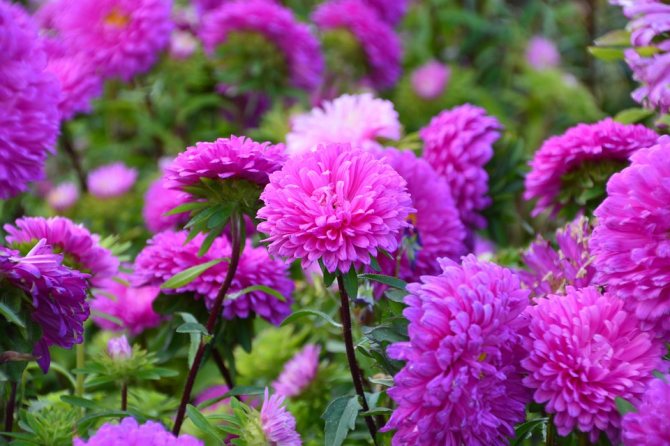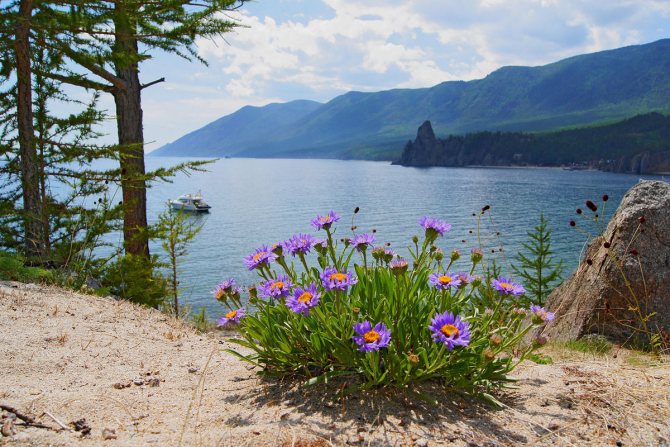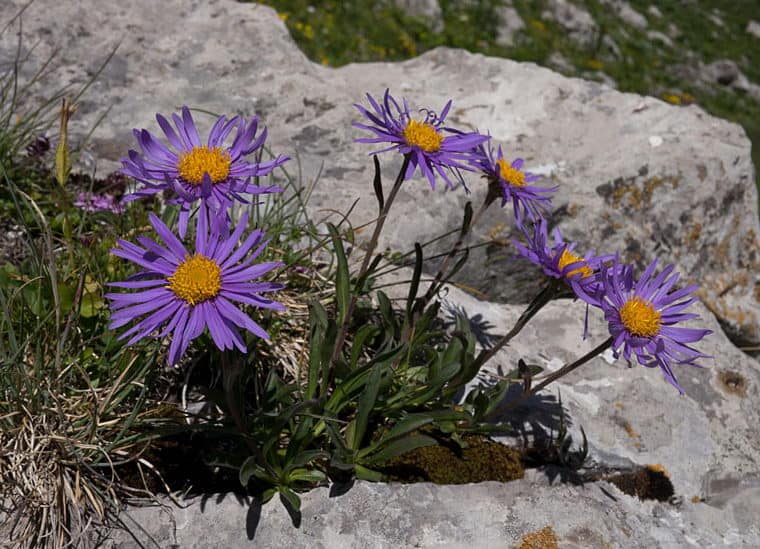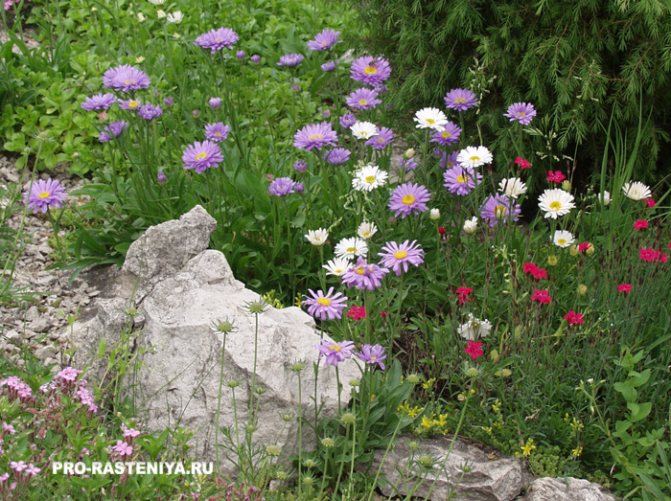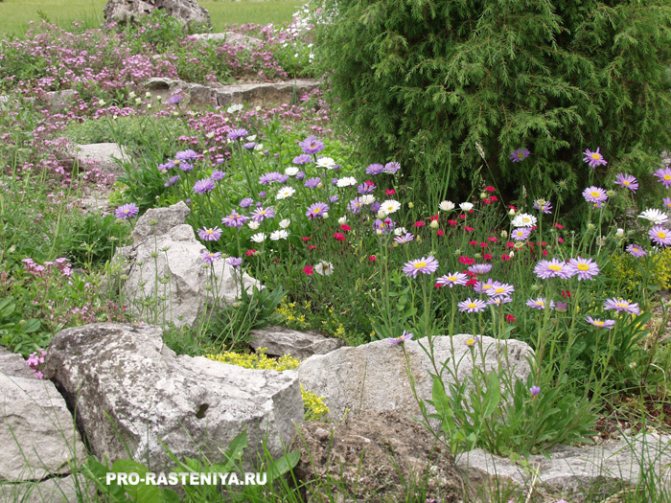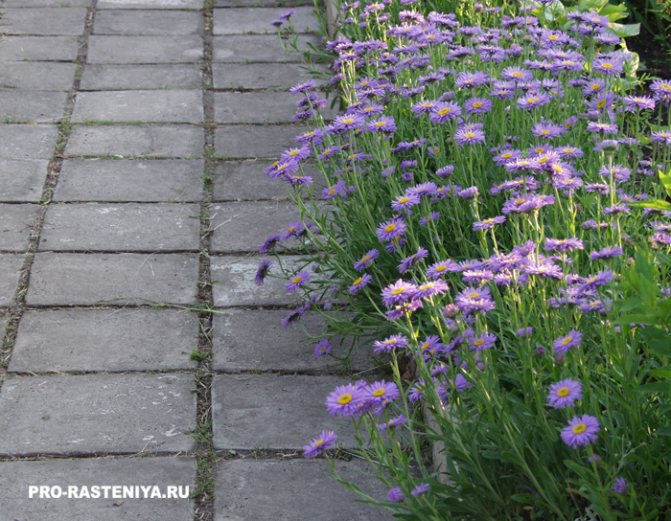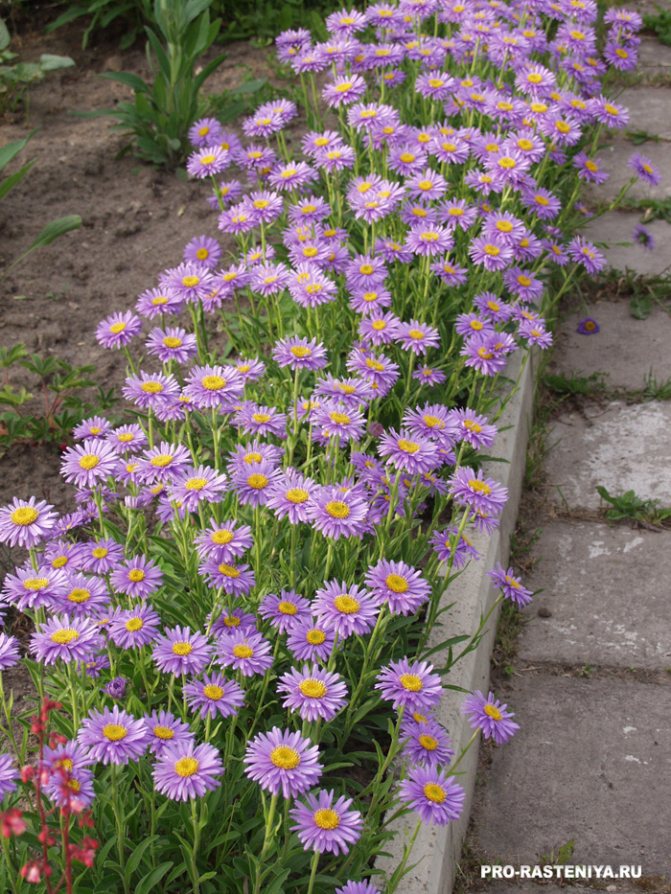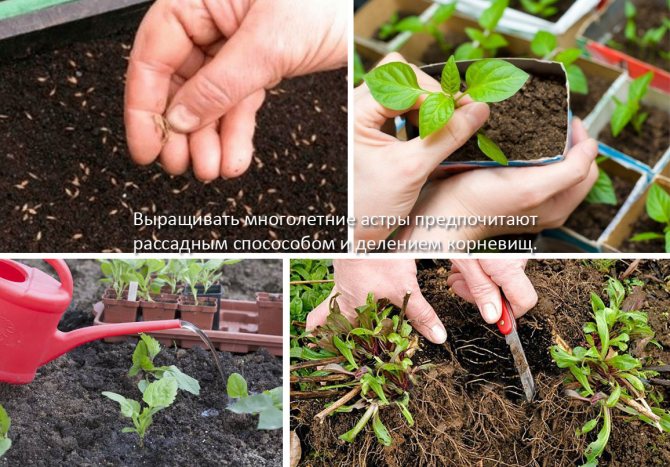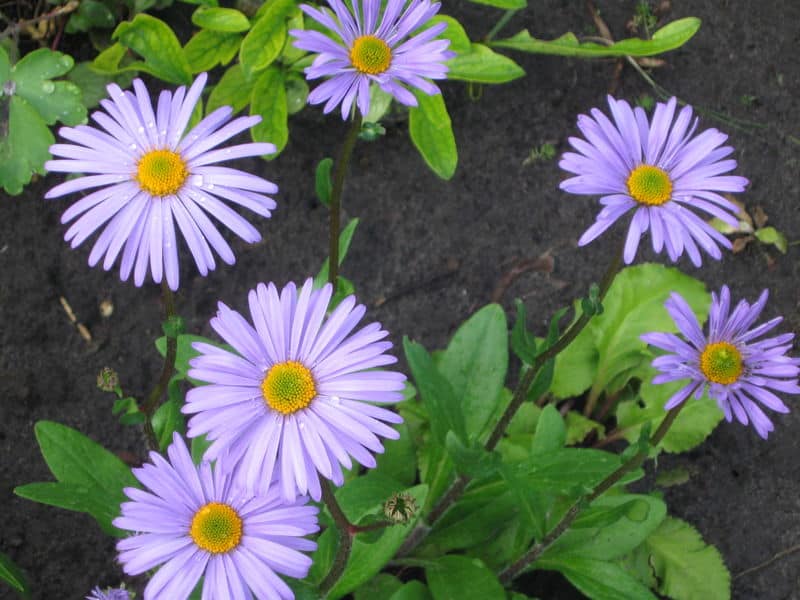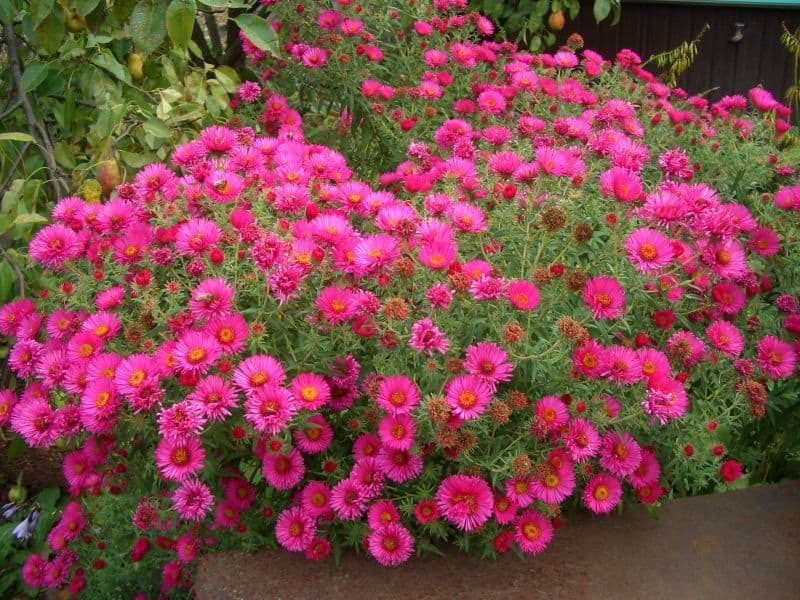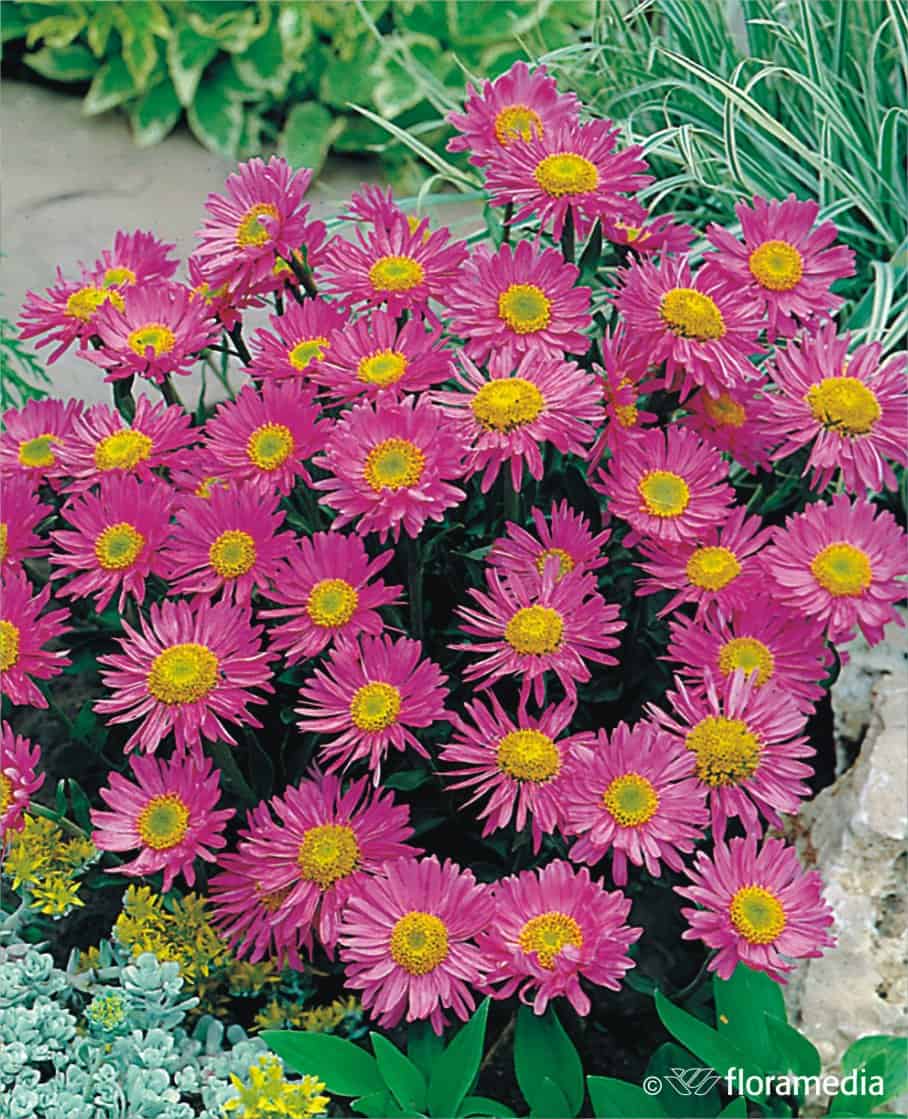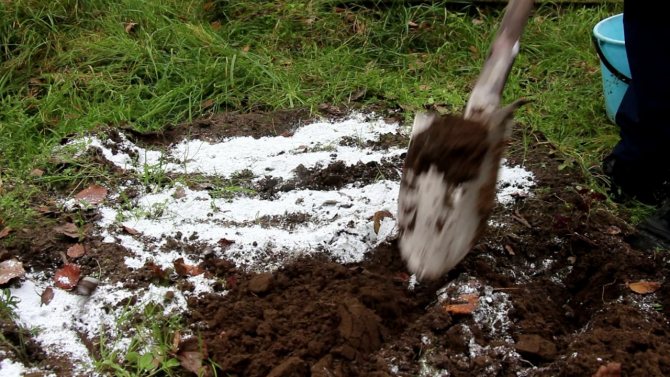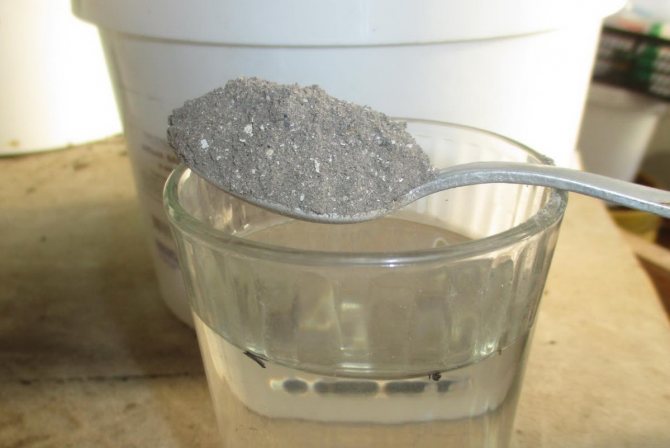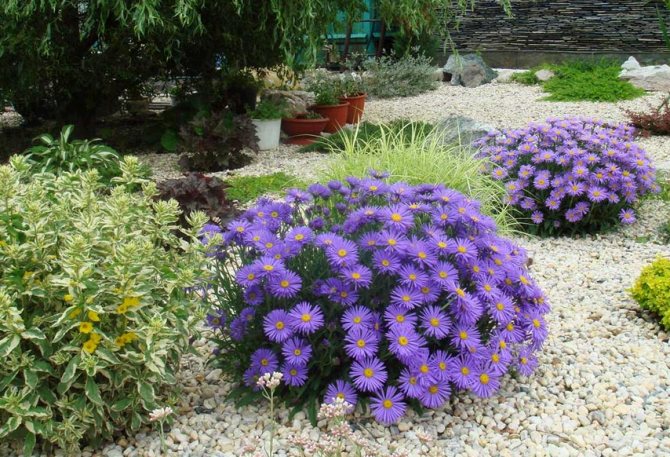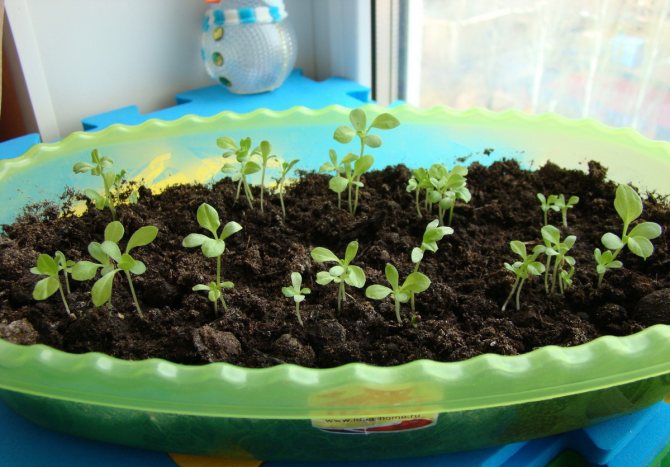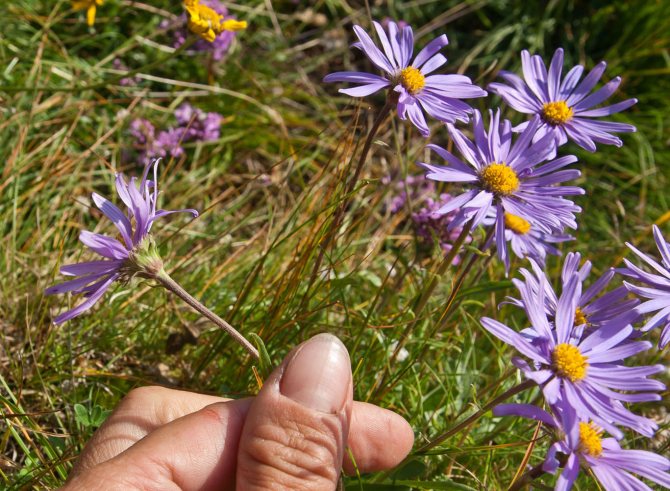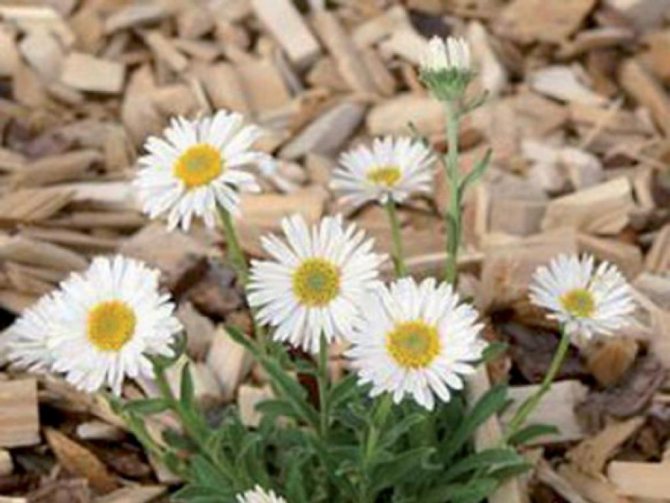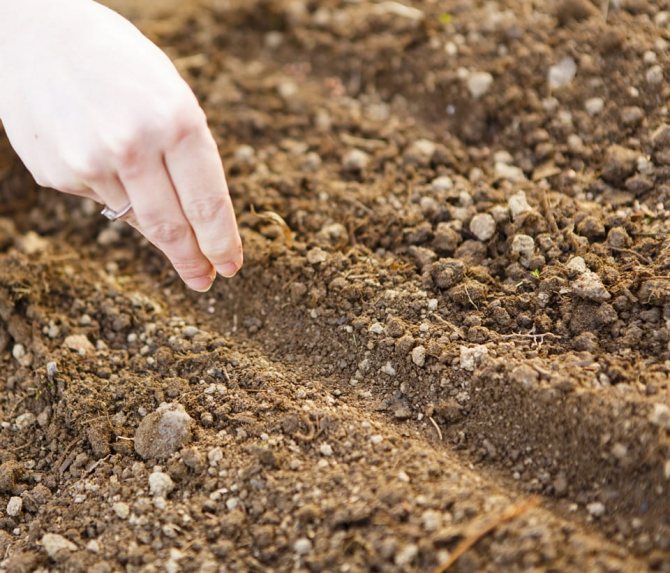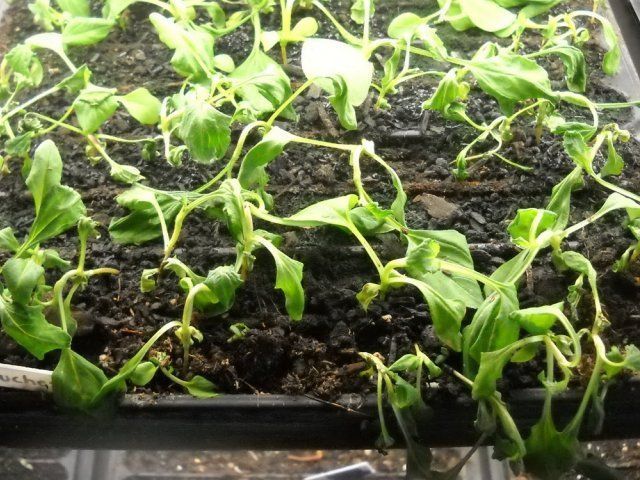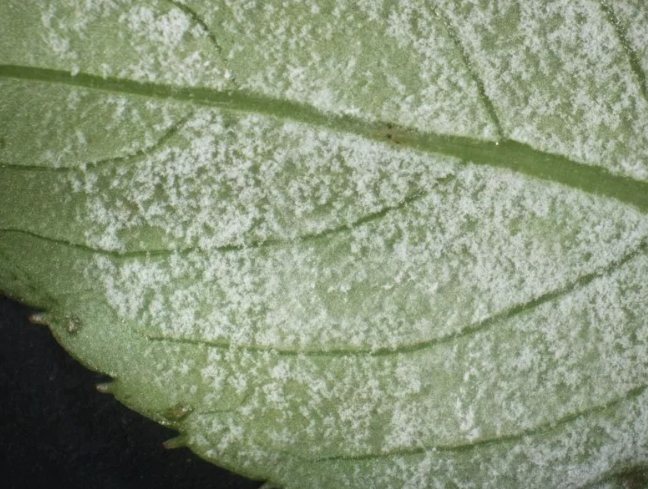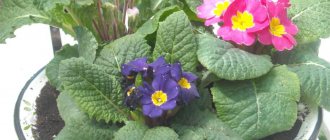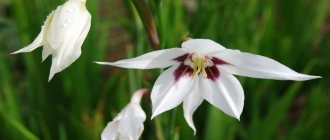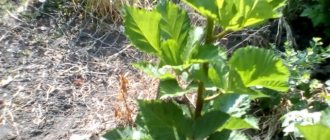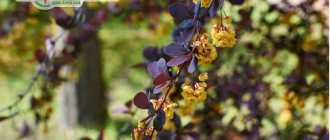What does the alpine aster look like
For its external similarity and natural region of growth, the flower is called mountain aster. Many species of plants have been bred with a height of 25 to 80 cm.
Plant characteristics
Brief description of the flower:
- stems are erect, pubescent, actively branching in the upper part, forming a dense bush;
- leaves are small, spatulate with a carved edge;
- flowers are collected in a basket with a diameter of up to 6 cm;
- achenes are small, oval, with a tuft in the upper part;
- the root system is fibrous with a small rhizome and numerous branches.

Spherical bushes of Alpine perennial asters are used for single and group plantings
What family does it belong to
Herbaceous perennial plant "Aster" subspecies "Alpinus" refers to ground cover shrubs and shrubs of the Asteraceae or Compositae family. The culture got its name from the Greek word "astra". Other names for the plant are Korzhinsky's aster or false aster.
Briefly about the history of appearance
Swedish botanist Karl Linnaeus described the flower in 1753. Breeders immediately drew attention to the species diversity of the culture and started breeding. Now there are more than 250 varieties and varieties.
Winter rest period
Before the onset of winter, the perennial aster should be provided with the conditions with which it can survive the cold period. The land around the bushes must be mulched. This will protect the root system of the plant from freezing. Sawdust or dry foliage is used as mulch.
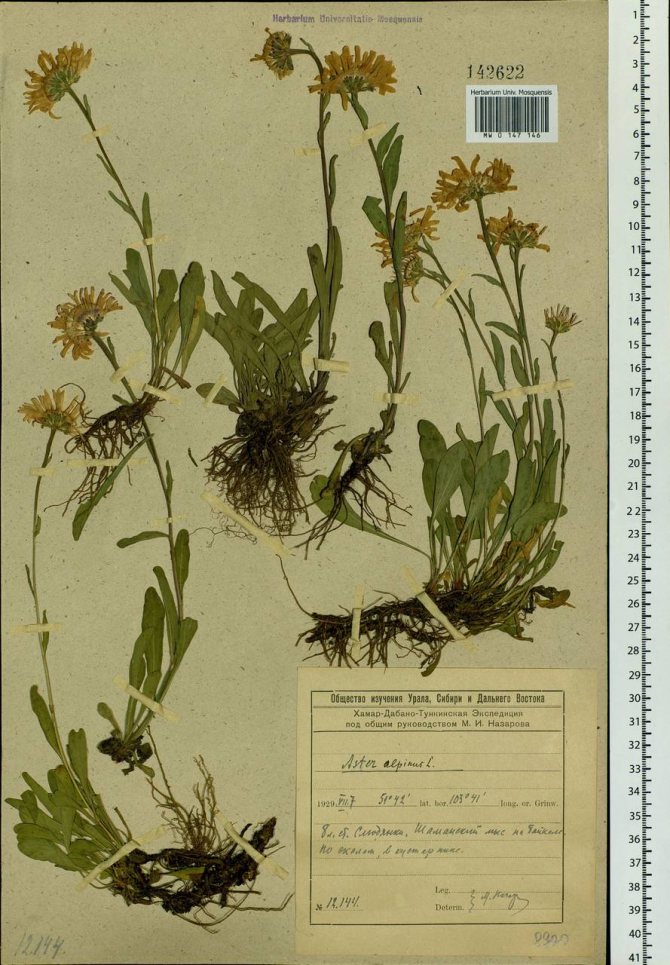

Most often, the green parts of the flower do not dry out and hibernate in this form. If the shoots with leaves have dried up, you should prune the bush from excess parts. Without this procedure, the aster will not be able to grow next spring. The flower does not require additional shelter, since the plant culture is quite resistant to the harsh climate. If the plant is grown in northern regions, it is advised to cover the base of the bushes with sand so that the buds do not freeze, from which new shoots will appear by spring.
With the beginning of the spring season, melted ice should be removed around the bushes. If moisture stagnates in the soil, the aster root system will deteriorate. In this case, not only the roots can be damaged, but also young stems, for which excess moisture at this time will be destructive.
Description of white, blue, pink types of asters
Aster novi-belgii (Aster novi-belgii)
Flowers are grown in many countries of the Northern Hemisphere. There are species in the wild that grow in southern Africa. Asters differ in the size and color of the buds, the height of the bush.
Popular varieties
- White Alps is a shrub 25-30 cm high, flowers resemble chamomile - a yellow center framed by white petals. Abundant flowering;
- Albus (Albus) - undersized variety of the Alpine aster. Shoot height up to 20 cm. White variety, baskets up to 4 cm in diameter;
- The line of Blue varieties forms semi-double buds of blue shades with a diameter of up to 8 cm. The height of the bush is up to 50 cm. Used for border planting;
- Illaria is a low-growing, frost-resistant variety. Various colors: white, pink, blue, blue;
- Pink is an early flowering species that blooms in May. Grows well in shady areas. Forms many baskets with a diameter of 4 cm;
- Rosea is another pink-colored, semi-double variety. Differs in rapid growth, every 3 years the bush has to be divided;
- Blue aster is distinguished by a violet shade of buds with a diameter of 6 cm. The shoots are low, up to 25 cm tall. Used for home cultivation;
- Alpine mix - collection of semi-double medium-sized varieties, used for alpine lawns.
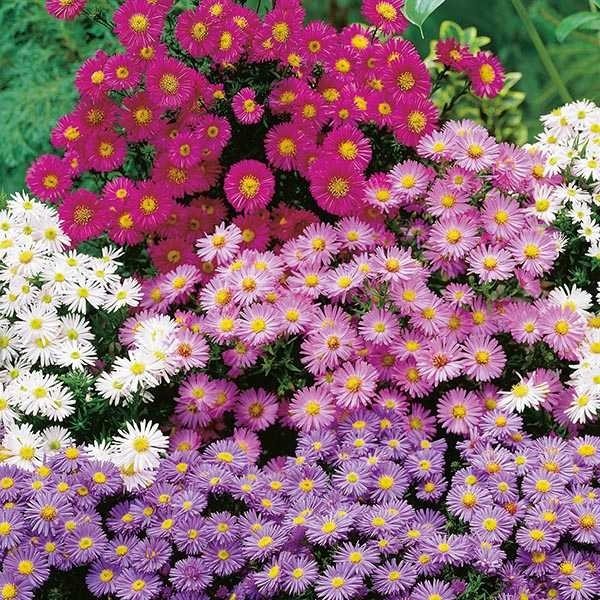

Aster is a perennial alpine mixture. Growing from seeds is possible by self-sowing
Popular flower varieties
Alpine asters differ in flowering time. Different types of plants can delight with attractive flowers in spring, summer or autumn. Several shrub varieties can only be found in South Africa. The star-like flowers have a bright yellow center and numerous ray-shaped petals.
Planting and caring for a perennial evening primrose flower
Popular types of false asters:
- Albus. The short stems have small, dark green leaves. Simple or semi-double flowers with white petals and a yellow center cover the entire spherical bush. The plant reaches 13-20 cm in height. Flowering begins at the very beginning of summer.
- Blondie. The plant culture, often grown for cutting flowers, grows up to 35 cm. The flowers are white pink or lilac-purple in color, resembling fluffy balls. Aster, unpretentious to care for, blooms in early June.
- Gloria. Plant height reaches 30−35 cm. A bush with emerald leaves is decorative until the end of autumn. Simple blue flowers, which appear at the end of May, are characterized by a diameter of 3-4 cm. Gloria is considered an unpretentious and disease-resistant variety.
- Goliath. The short plant is distinguished by semi-double flowers of a light purple hue. This species tends to grow rapidly, so a large area is required for its cultivation.
- Dark Beauty. A picturesque bush, reaching 15 cm in height, has bright purple flowers. This variety is often planted between stones, resulting in a picturesque landscape.
- Dunkle Chenet. A lush plant that grows up to 25 cm, has purple baskets. The saturated tone of the flower looks favorably against the background of greenery and flowers of other types.
- Rozea. The bush grows up to 16-22 cm. Flowers with a greenish-yellow center and pink petals appear in early July, decorating a spherical bush. This species is also recommended to be planted near stones.
- Ruber. The plant has a rich color of red-pink flowers. The bush grows up to 30 cm and can decorate the garden with both single plantings in the flowerbed and planting along the paths.
- Superbus. During the flowering period, openwork bushes are decorated with lilac-blue flowers. The variety is unpretentious, does not require special care and can develop even in shaded areas.
- Happy end. The early flowering variety is characterized by shrubs at least 35 cm high. The pink-flowered Alpine aster has an abundant flowering that begins in May and ends in July. This variety will look spectacular along the paths.
By combining different varieties, you can achieve a vibrant landscape and continuous flowering from the very beginning of spring to the beginning of winter. Asters are in harmony with many colors, so they will fit into any floral arrangement. If you wish to arrange a summer cottage plot with asters alone, you can add octobrines, septenbrines, Belgian, Italian, New Zealand and other types of perennials to the alpine varieties.
Peony spray roses: an overview of common varieties
Growing from seeds
New varieties of flowers come to Russia by seeds. Novice gardeners will be helped by a small instruction on the agrotechnics of alpine chamomile: growing, care, transplanting. Seeds retain their germination capacity for no more than 2 years.
Planting capacity and soil
Perennial aster - shrubs
Sowing is carried out in individual pots or a common planting container with holes for water drainage. Astra is recovering well after transplantation. As for the soil:
- do it yourself, mixing 1: 1 sod and compost soil;
- get ready-made potting mix, universal or for cucumbers.
Note! The earth is spilled with boiling water, the seeds are embedded in the warm earth. They create greenhouse conditions by covering with foil.
Seed preparation and sowing
It is advisable to keep the inoculum in a pink solution of manganese for 2–4 hours to prevent fungal infections. Seeds are scattered on damp ground, covered with a layer of dry soil 1 cm thick on top. Seedlings appear in 4-6 days.
Timing
The buds appear in 1.5 months. Depending on climatic conditions, sowing is carried out at the end of February to mid-March.
How to care for seedlings
Moisten the ground with a spray gun as it dries. Seedlings are placed on the south side or try to grow backlit shoots. Periodically loosened so that a crust does not form. Top dressing begins after the pick, when the 4th full-fledged leaf appears.
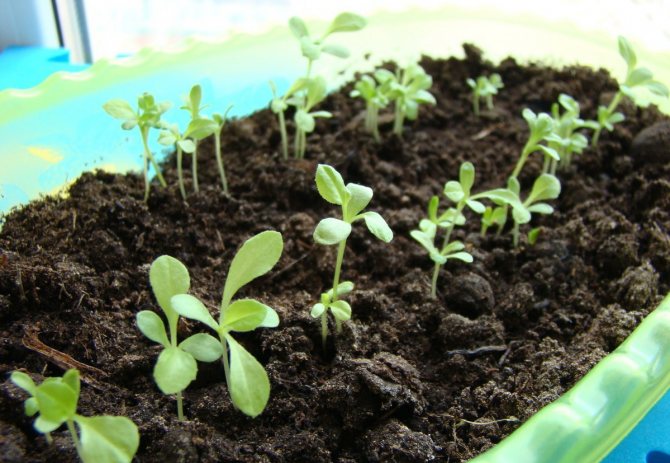

Aster seedlings after picking, plants do not have to be placed in separate pots
Landing in open ground
Plants are transplanted to a permanent place after recurrent frosts. Before this, the seedlings are hardened - they are taken out to a cool place for several hours. Before planting, the soil is spilled with a solution of fungicide or manganese. The roots are pinched by 1/3 so that they grow better.
Planting in a seedless way
Aquilegia - growing from seeds
It is difficult to grow a perennial in a permanent place, you need to constantly look after the seedlings. Seeds are sown immediately after the snow melts, covered with foil. Seedlings will appear in a couple of weeks. The plantings loosen, thin out or dive the plants, leaving between the bushes from 30 to 5 cm, depending on the width of the formed crown. At the end of summer, the buds that appear are cut off, allowing the aster to take root.
Note! It is allowed to sow seeds before winter, in frozen soil.
How Alpine perennial aster reproduces
To preserve the species, varietal hybrids are propagated in a vegetative way: by cuttings or rooted cuttings.
Dividing the bush
Bushes older than 3 years are divided, the operation is carried out throughout the season. For rooting before wintering, the aster will take a month. The bush is divided with a sharp knife, shaking out the earthen ball. Before planting, the cuttings are kept in water for at least 3 hours.
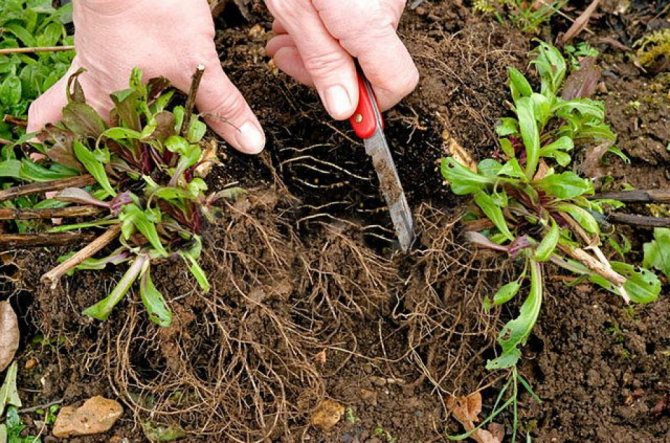

When separating parts, the main thing is not to damage the growth points so that there is a rapid growth of new bushes
Cuttings
Shoots are cut into pieces so that there are 3 leaves on each cuttings. Immersed in a solution with a growth stimulant. Rooted in the potting mix after the appearance of white roots. It is better to plant cuttings in open ground in spring or at the very beginning of autumn.
Care
Perennial aster does not require careful supervision. Watering should be done in moderation, making sure that the water does not stagnate. During flowering, the soil should be moistened more.
Attention! If the place is sunny, open, the flower will delight with abundant development, stable flowering. In the shade, it may not bloom at all, this should be taken into account when choosing a place for planting.
Prefers the earth, water and breathable, light. When exposing the roots, they need to be sprinkled or transplanted to the bush, deepening to the required depth.
The plant is capable of degenerating, becoming a little smaller. Regular transplant and renewal will help prevent this development.
Features of caring for aster alpinus at home
Bushes are good not only in the garden, but also at home. They begin to bloom in June, continuing to emit buds until October. If the aster is properly looked after, it will delight for many years.
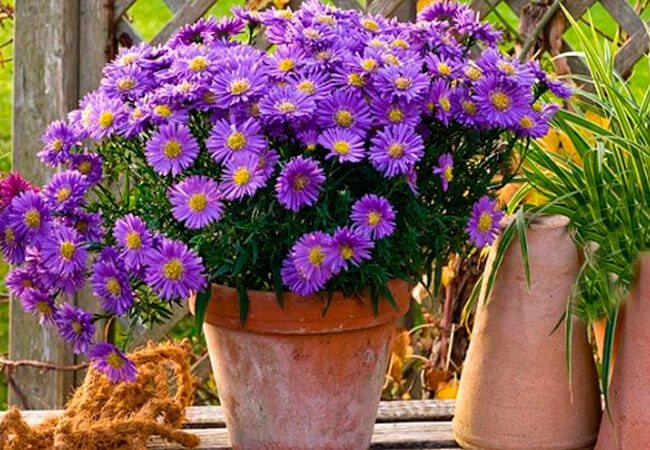

Blue alpine aster undersized looks good in pots
Temperature
During the flowering period, the maximum temperature is no more than + 27 ° C. In winter, during the rest period, the pot is removed to a cool place, where it is not higher than + 18 ° C.
Lighting
Aster grows well on the south and east side, backlighting is required on the west and north flower.
Watering
The bush needs water in spring, summer. Aster is watered by sprinkling. Since October, watering is reduced, the earth is moistened with a spray bottle, and the earthy coma is not allowed to dry out.
Spraying
In the spring, the bush is washed under the shower, with the onset of heat, it is regularly sprayed so that the leaves breathe.
Humidity
The flower is susceptible to root rot, does not like stagnant water. The bush tolerates dry winter air normally.
Priming
Vermiculite or coconut fibers are added to the soil mixture to retain moisture. The pH level is maintained within the range of 5.5–6.5.
Top dressing
The flower is fed regularly, every 2 weeks, ¼ of the norms of complex fertilizers for home flowers are added to the water for irrigation. During the budding period, they are treated with "Ovary" or "Growth".
Shrub aster
Shrub aster bushes up to a meter high and above, especially a frost-resistant type of aster, grows poorly in heat, does not tolerate drought, and does not like damp places either.
Shrub aster blooms from August to October. It is advisable to plant bushes on the south side, in a sunny place. Very good for dry bouquets.
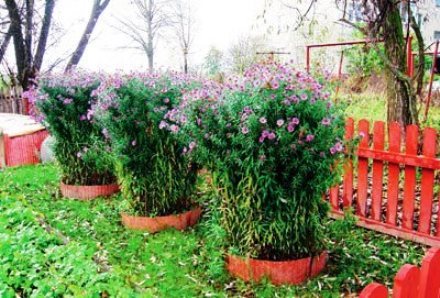

To do this, several plants need to be tied up and hung to dry with flowers down for 2-3 weeks in a dry, ventilated place.
Aster shrubby undersized and with abundant flowers formed into spherical bushes. The flowers are small, needle-like with a diameter of 2.5-3 cm.
When and how it blooms
The buds are medium-sized, the diameter varies from 3 to 8 cm. There are up to 100 inflorescences on the bush.
Types of flowers
The petals are the ligulate flowers of the aster. In the center - tubular, the envelope is formed from transitional flowers.
Flower shapes
Most varieties have flat disc-shaped, there are species with semi-double and double baskets.
Flowering period
Early flowering varieties bloom in May, release flower arrows until the end of August. The rest of the asters bloom from July to October, some species bloom until the end of October.
Changes in care during flowering
Throughout the entire period, complex fertilizers are applied twice a season. Faded buds are cut off.
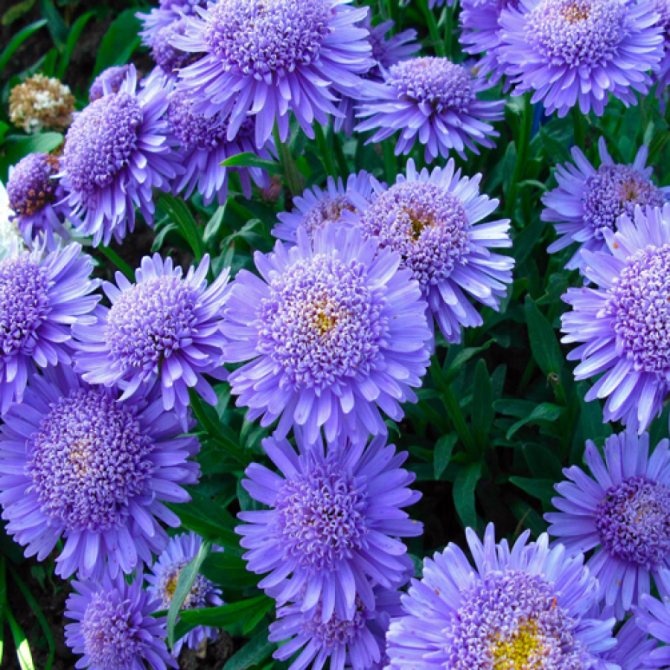

In the Blue aster, tubular flowers form a hemispherical cap, testes are formed only in the central part of the basket
Diseases and pests
Prevention and control of plant diseases is an integral part of care. In principle, aster demonstrates good resistance to ailments affecting horticultural crops.
However, growing in unfavorable conditions can provoke a number of diseases, for example:
| Fusarium Symptoms:
Provoking factor:
Treatment:
| |
| Jaundice Symptoms:
Provoking factor:
Treatment:
|
| Blackleg Symptoms:
Provoking factor:
Treatment:
|
| Powdery mildew damage Symptoms:
Provoking factor:
Treatment:
|
| Spider mite Symptoms:
Provoking factor:
Treatment:
|


